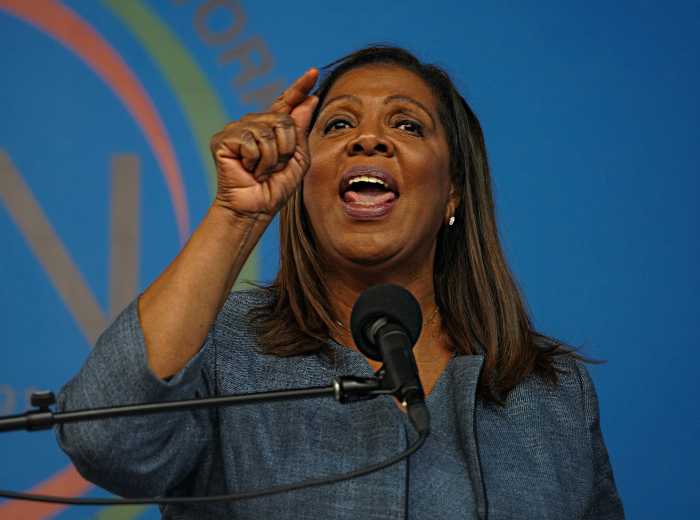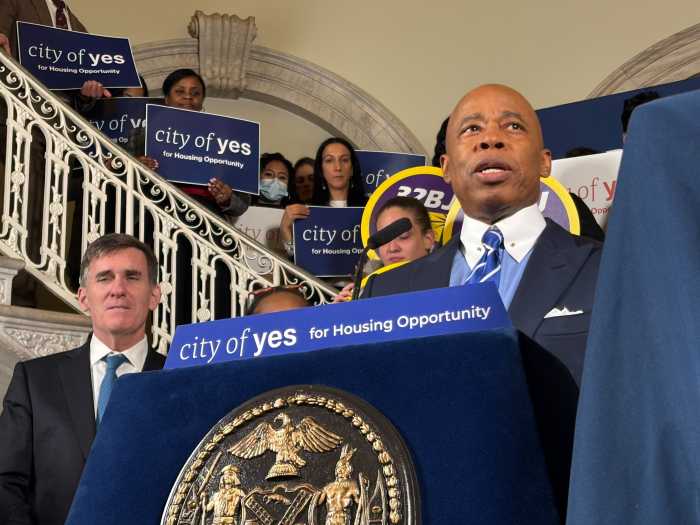BY ALINE REYNOLDS | Downtown residents’ wish to have their own ceremony at the National Sept. 11 Memorial for the 10th anniversary of 9/11 was never granted. Instead they were given what some community members feel is an equally good opportunity for reflection: special access to the memorial on the first Sunday of every month.
Assembly Speaker Sheldon Silver invited an estimated 2,000 Lower Manhattan residents to the memorial’s first “Community Evening” on Sunday, Oct. 2. Starting at 4 p.m. only people who produced identification proving they lived in a Lower Manhattan zip code, were allowed into the memorial.
Mayor Michael Bloomberg made a brief appearance at the site while en route to the Yankees game, while Speaker Silver, Borough President Scott Stringer, Congressman Jerrold Nadler and other elected officials greeted the roughly 1400 residents that attended the event.
“The community has suffered as a result of the rebuilding effort,” said Silver during a short break he took from greeting community members to talk to reporters. “I think it’s important for them to see what’s the result of their suffering.”
Community members, in turn, had mostly positive things to say about their very first visit to the memorial.
“I can’t imagine anything more perfect,” said Battery Park City resident Juliet Burrows, who waited out the brief afternoon rainfall with her family to locate the names of deceased friends and acquaintances on the plaques that line the sides of the two reflecting pools.
“The waterfalls are just breathtaking,” said Burrows. “They completely capture the scale of the buildings and the scale of the tragedy.”
The “community evening” is an appropriate setting for local residents to unite the same way they did in the days and weeks after 9/11, according to Burrows’s wife, Kim Hostler. Visiting the site with fellow Downtowners, she said, felt “tender and emotionally safe.”
“Otherwise, you’re afraid of that overbearing tourist experience,” remarked Hostler.
B.P.C. resident Karen McDermott said she accepted Silver’s invite only after hearing that her friend and neighbor, Nartya Subramaniam, was available to join her. The two women, who were both displaced from their homes at 200 Rector Place, met at meetings held by the building’s residents over the months following the attacks where they shared their personal experiences.
As for the memorial, “they really thought through every detail,” said Subramaniam. “I think it’s really just perfect the way they organized [the names], rather than just alphabetical order.”
“I find it very beautiful that you can actually touch the person’s name. It’s a very moving experience,” echoed NoLita resident Georgette Fleischer as her fingers traced the name of a deceased firefighter she knew.
For Financial District resident Sharon Schuermann, walking next to the Twin Towers’ footprints brought back memories of shopping in the lobby of the South Tower just a half hour before the attacks. The layout of the memorial, Schuermann said, is “really effective” in commemorating the day.
“I like the black holes in the middle, and the sound of the water, which masks out all the noise,” said Schuermann.
If it weren’t for the community evenings, some local residents that recently reserved a visitor’s pass, such as Lower East Side resident Dean Mellis, would have had to wait for weeks and in certain cases, months, to access the site.
“I signed up on the [web]site, and the earliest I could get through was mid-December,” said Mellis.
Mellis said he was delighted to visit the memorial when it wasn’t packed with hoards of tourists.
“It’s very moving to see there’s life and reconstruction, instead of people from out of town who want to look at this,” said Mellis.
Some community members voiced interest in coming to the memorial on a regular basis — and not necessarily on Sundays.
“I think it would be good if they were able to work out security issues so there was a way for people to come more easily on lunch breaks, for example,” said Lower East Side resident Bonnie Hulkower.
“I think it’s very important that the people from this neighborhood have access to come here,” said Helena Fiscra from Battery Park City. “This is their neighborhood, and they still feel the same way years later.”
Visiting the site was also poignant for Tribeca resident Jean Grillo, a public member of Community Board 1 whose niece evacuated the South Tower just in time to survive. She and her daughter, Aria, visited the site together to pay their respects to the former head of security for Morgan Stanley, who Aria said died helping to save her cousin and others; as well as a firefighter who was the father of Aria’s friend.
The Grillo family was very pleased with the layout of the plaza.
“I remember joking about the barren, awful plaza that had been there [before],” said Grillo. “We actually like the trees — they have a very, very humanizing, organic effect.”
Having the community evenings, “is a wonderful way to say, ‘you guys were also first responders,’” said Aria, who served meals to recovery workers at St. Paul’s Chapel ion the days after the attacks.
“This is our neighborhood — it was our neighborhood before it was a Ground Zero,” said Aria.
When asked how often she planned on visiting the memorial, “We’ll always be coming here,” the younger Grillo replied, “because it’s our home.”






























